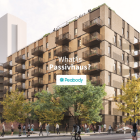What is the Future Home Standard?
When you buy a new home, you’re not just choosing bricks and mortar, you’re choosing how you’ll live for years to come. The UK Government’s Future Homes Standard (FHS) is set to transform that choice from 2025 onwards, ensuring that every new build is designed for a low carbon future.
This is not a minor update to the building code. It’s one of the most significant shifts in housing policy for a generation, aiming to make new homes dramatically more energy efficient, cheaper to run and far better for the planet.
The Future Homes Standard is a UK government policy that mandates all new homes be zero carbon ready from 2025 onwards.
What will the FHS deliver?
The Future Homes Standard sets out a clear ambition: homes built after 2025 must be zero-carbon ready. In practice, that means big changes for new builds:
1. Massive carbon reductions
New homes will emit around 75-80% less carbon than those built to the 2013 standards. This leap forward will put housing on track to support the UK’s Net Zero goal for 2050.
2. Goodbye to gas boilers
Gas and oil heating systems are being phased out for new properties. Instead, homes will feature low carbon solutions like air source and ground source heat pumps.
3. High performance building fabric
The fabric first approach means walls, roofs and windows will perform far better. Expect triple glazing to become the norm and thicker, more efficient insulation.
4. Year round comfort
The Standard doesn’t just keep homes warm in winter, it also considers overheating in summer. Better ventilation systems and thoughtful design will improve indoor air quality and reduce the risk of homes becoming too hot as the climate warms.
Why this matters for the planet
Housing accounts for roughly a quarter of the UK’s greenhouse gas emissions, mostly from heating. Building greener homes is one of the fastest, most cost effective ways to cut carbon emissions.
Every new property that meets the Future Homes Standard will lock in decades of lower energy use, meaning we won’t have to spend money later retrofitting homes to meet environmental targets.
Switching to low-carbon heating also reduces reliance on imported fossil fuels, protecting households from volatile gas prices. Combined with rooftop solar panels and battery storage, which many developers are now including, new homes will be cleaner, cheaper to run, and more resilient to future energy shocks.

Key benefits for buyers
Lower Bills: Highly efficient heating systems and well insulated walls mean you’ll spend much less on energy each month.
Better comfort: Fewer draughts, more consistent temperatures and fresh air systems that keep humidity and condensation under control.
Future proof living: No need to pay for disruptive retrofits in ten years’ time, your home will already meet tomorrow’s energy expectations.
A step towards Net Zero
The UK has committed to cutting carbon emissions to Net Zero by 2050. Housing is a major piece of that puzzle and because homes last for generations, what we build today will shape the country’s carbon footprint for decades.
The Future Homes Standard is a vital part of that journey. By making all new homes low carbon, highly efficient, and future proof, it ensures that the homes we move into after 2025 will be ready for a greener, cleaner future.

The Future Homes Standard is about more than just compliance. It’s about creating homes that cost less to run, protect the environment, and provide better living conditions for everyone. For anyone considering a new build in the next few years, it represents a win-win: a home designed for comfort and savings today, and a property that will stay ahead of environmental regulations tomorrow.
If you’re exploring your options for a new build home, pay close attention to how developers are preparing for the Future Homes Standard. Choosing a home that meets or exceeds these requirements is not just a smart financial decision, it’s a step towards a more sustainable future.
Article overview
The UK’s Future Homes Standard will make all new homes zero-carbon ready, cutting emissions by 75-80%. It phases out gas boilers, requires better insulation, airtightness and ventilation, ensuring year round comfort. Buyers benefit from lower bills, healthier living spaces and homes future proofed for net zero goals.
Article overview composed with the help of AI
Disclaimer
newhomesforsale.co.uk is an information platform and not a financial advisor, mortgage broker or mortgage lender. Always get financial advice before making significant decisions about your money, mortgages and buying a house.

Publish date 3rd October, 2025
Reading time: 5 minutes
Written by Heather Bowles



